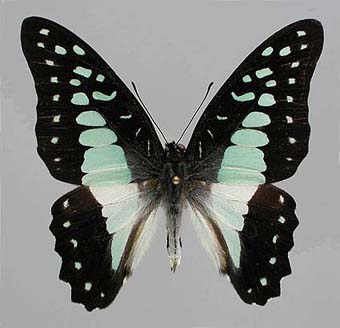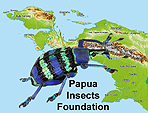

Papua-Insects.nl
The Papua Insects Foundation
The Swallowtails (Lepidoptera: Papilionidae, Papilioninae) of Papua Indonesia
by Jan Moonen
Graphium (Graphium) eurypylus (Linnaeus, 1758)
ssp. lycaonides (Rothschild, 1895)
references and synonymy:
Papilio eurypylus var. lycaon: Kirsch, 1887 (Korido, Supiori)
Papilio eurypylus pamphilus: Grose-Smith, 1894 (Humboldt Bay)
Papilio eurypylus var.: Ribbe, 1886 (Aru Islands)
Papilio eurypylus lycaonides Rothschild, 1895 (TL : Humboldt Bay, Ati-Ati-Onin, Fergusson Island); Jordan 1908-1909 (Waigeo, Japen); Rothschild, 1916 (Utakwa river: Canoe Camp)
Papilio eurypylus priscus Fruhstorfer, 1907 (TL: Waigeo) (synonym)
Papilio eurypylus priscus f. aurifer Fruhstorfer, 1907 (synonym)
Graphium eurypylus: Ford, 1944; Munroe, 1961; Saigusa et al., 1982; Igarashi, 1984; Parsons, 1998
Graphium eurypylus lycaonides: D’Abrera, 1971; Tsukada & Nishiyama, 1982: (Waigeu, Japen, Papua, D’Entrecasteaux Islands, N.E. Australia)
Graphium (Graphium) eurypylus: Hancock, 1983
Taxonomic and general notes
The geographical range of the species Graphium eurypylus Linnaeus is spread over most of the Indo-Australian Region: from North India to South China, Vietnam and Hainan Island and also includes Malaysia, Andaman Islands, Indonesia, the Philippines and New Guinea, the Bismarck Archipelago and North and East Australia. This species does not occur in South India and Sri Lanka, nor in Japan (cf. Parsons, 1998). However, the very similar species Graphium doson Boisduval does occur in these three regions, but does not reach the Papuan region.
Jordan (1909) stated that Graphium eurypylus is a Papuan species, whose range is extended westwards, while G. doson is an Indo-Chinese species that is spread eastwards to Sumbawa and the Philippines and South Japan.
The subspecies lycaonides Rothschild flies on the mainland of New Guinea and the surrounding islands. Of these islands, Waigeo, Aru, Japen and Supiori are mentioned in literature, as well as the Papua New Guinea islands of Manam and D’Entrecasteaux (Parsons, 1998).
The form aurifer Fruhstorfer has yellow spots on the underside instead of red spots. According to Ford (1944) Graphium species have a red pigment of ‘Type A’. This pigment is to turn to yellow in a vapour of concentrated HCl and back to red in a vapour of ammonia. So it is likely that the form aurifer is due to a genetically defined low pH in the scales.
Fruhstorfer described specimens from Waigeo as priscus, but in the same article he states that the lycaonides from Deutsch- und Britisch-Neu-Guinea is very like his priscus from Waigeo.
fig. 2 Graphium eurypylus lycaonides (male, a. upperside, b. underside), Sarmi, Dabra – Mamberamo area (KSP)
fig. 3 Graphium eurypylus lycaonides (female, a. upperside, b. underside), Hollandia (Jayapura) (RMNH)
Distribution
STATUS: Widely distributed in Indo-Australia (see above). A rather common species. The caterpillar feeds on Annonceae.
PAPUA LOCALITIES: Waigeo; Numfor: Namber; Japen; Supiori: Korido; New Guinea: Ampas, Ati-Ati-Onin, Batimban, Beaufort Bivak, Borme, Dabra, Dafensero, Dojo, East Tami, Jayapura, Jila, Juruf, Karubaga, Kloofbivak, Kobakma, Kwerba, Lereh, Miei, Modio, Nabire, Prafi, Sabang, Senopi, Sentani, Sorong, Tamrau Mts., Uapa, Ubrub, Werba, Wolong River. Details in gazetteer.
EXTERNAL DISTRIBUTION: Andaman Islands, Sikkim, Assam to South China, Indochina, Malaysia, Philippines, Indonesia to New Guinea, Queensland and N.S.Wales, Bismarck Archipelago.
DATA SOURCES: KSP, RMNH, Literature (see below).
Literature
Collins, N.M. & M.G. Morris, 1985. Threatened Swallowtail Butterflies of the World. The IUCN Red Data Book. vii + 401 pp + 8 pls. IUCN, Gland, Switzerland & Cambridge, U.K.
Daawia & Supeni Sufaati, 2007. Survey on food plants of larvae and butterflies of the Papilionidae at the Reserve Cyclops Mountains. Suara Serangga Papua ed. III Jan-March 2007.
D'Abrera, B., 1971. Butterflies of the Australian Region. Lansdowne Press Pty Ltd, Melbourne: 415 pp.
Fruhstorfer, 1907. Neue Papilio-Rassen aus dem Indoaustralischen Gebiet. Entomologische Zeitung 21(30):182-184 (9 nov. 1907)
Jordan, K., 1908-1910. Papilionidae, Papilio bis Armandia. in Seitz: Großschmetterlinge der Erde. Die Indo-Australische Tagfalter. IX:11-109,112; Pls.1-49.
Linnaeus, 1758. Systema naturae (ed. 10) 1:464
Mastrigt, H.van & E. Rosariyanto, 2005. Kupu Kupu, Untuk Wilayah, Mamberamo Sampai, Peg. Cyclops. Conservation International Indonesia
Parsons, M., 1998. The Butterflies of Papua New Guinea. Their Systematics and Biology. Academic Press. San Diego, etc.
Rothschild, W., 1895. A revision of the Papilios of the Eastern Hemisphere, exclusive of Africa. Novit. zool. 2(3):167-463 pl.4 (Aug. 1895)
Rothschild, W., 1916. Lepidoptera collected by the British Ornithologists’ Union and Wollaston Expeditions in the Snow Mountains, Southern Dutch New Guinea. Reports on the collections B.O.U. exp. and W. exp. Vol.II. London, 1916 (Papilionidae p.1-4)
Tsukada, E. & Y.Nishiyama, 1982. Papilionidae. In Tsukada, E. (ed.) Butterflies of the South East Asian Islands. 1 457 pp. Plapac Co. Ltd. Tokyo [NB Japanese edition 1980]
